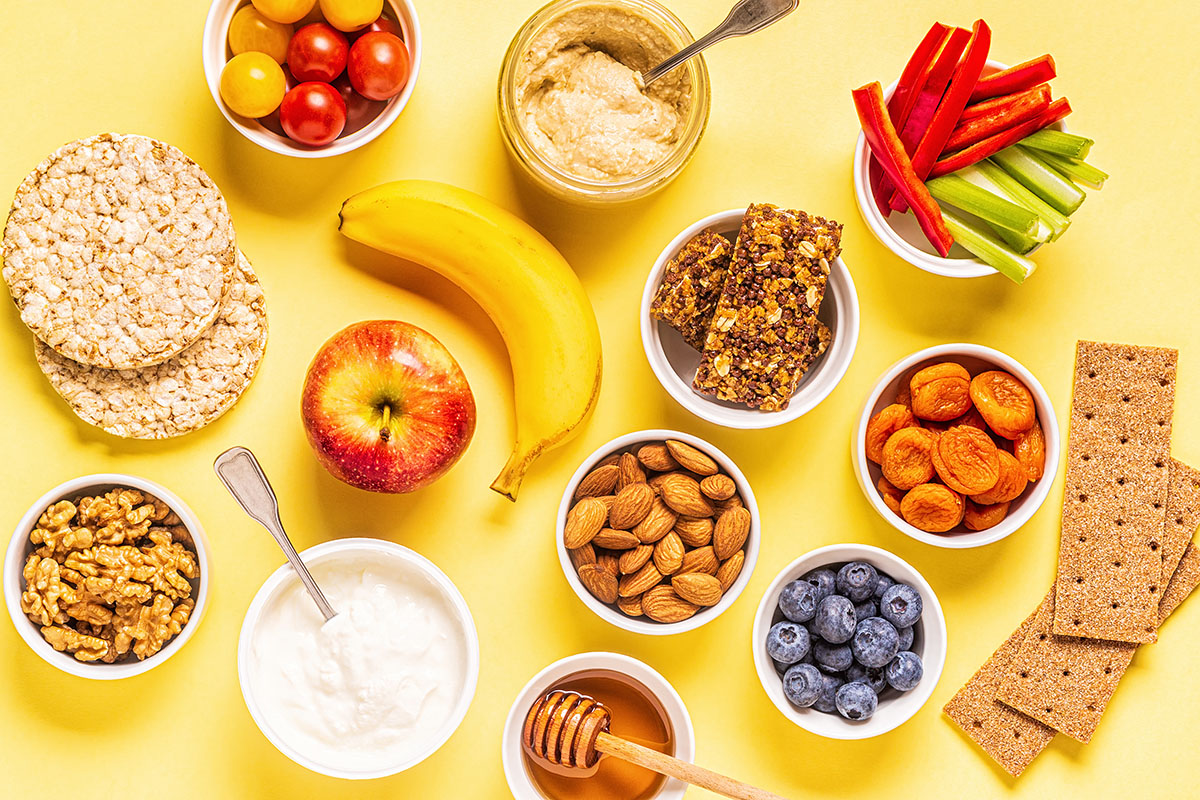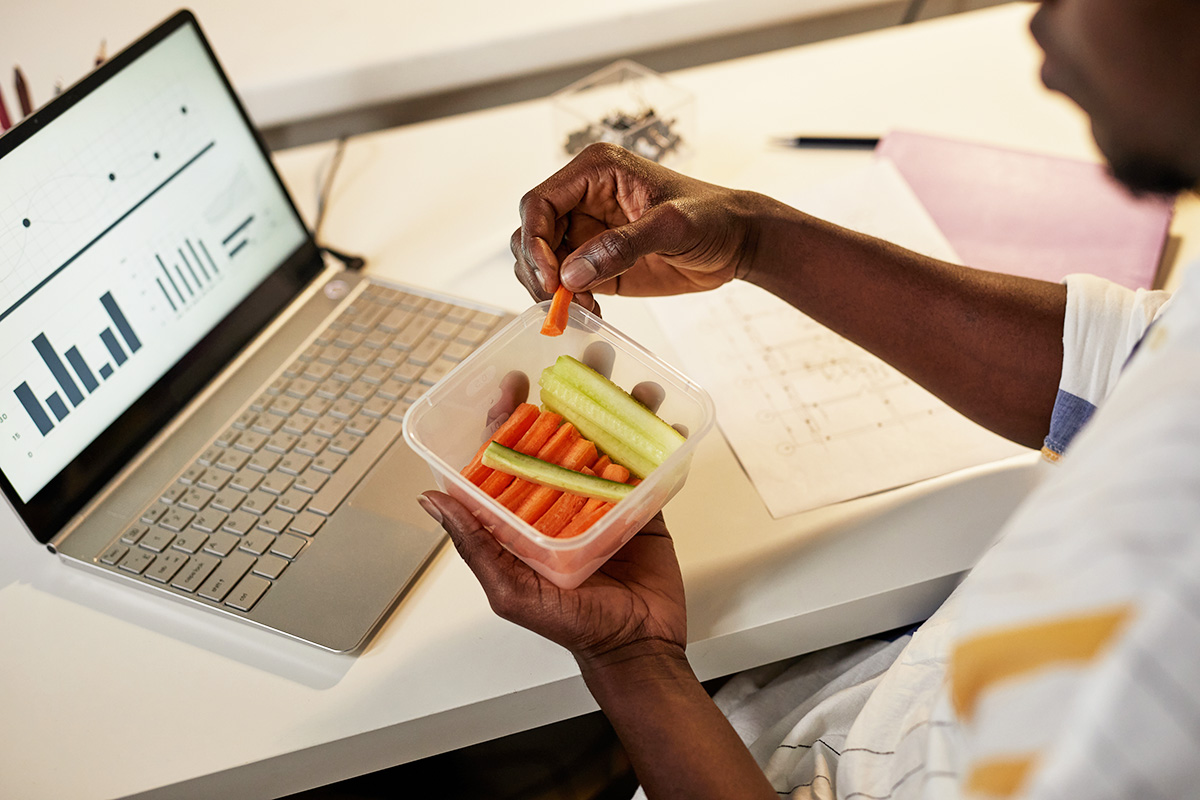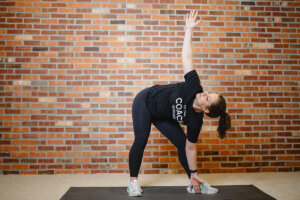As diet culture has evolved and nutrition fads have come and gone, snacking has gained a bit of a bad reputation. You may have been told that cutting snacks can prevent weight gain or help you lose weight. But what if snacking could actually play a valuable role in your overall health and nutrition? We’re here to dispel the myth that eating snacks will derail your health goals — and talk about how smart snacking can help you achieve them faster.
How snacking supports your health goals
Done right, snacking is a tool for meeting your nutritional needs, whether you’re trying to lose weight, build muscle, or stay at a healthy weight. Eating snacks throughout the day can help you maintain steady energy, eat more balanced portions during meals, refuel after a workout, and regulate your blood sugar. The way you plan your snacks — or what you snack on — may change based on your goals.
Making macros count
Whether you’re bulking or losing weight, keeping track of your macronutrient (aka macro) intake can be a helpful strategy for managing your nutrition and setting realistic goals. Put simply, macros are the three essential nutrients our bodies need for energy: protein, carbohydrates, and fat. Your recommended macro ratio is determined by your health and fitness goals, your current body composition, and your daily energy levels. Snacking can help you hit your daily macronutrient needs if your meal plan doesn’t cover them alone.
Snacking for weight loss
Generally, weight loss comes down to energy in (calories) vs. energy out (activity). If you consume fewer calories than you spend in a day, the result is weight loss. Does that mean you should cut snacks from your diet entirely? Not necessarily.
If you’re aiming to lose weight, snacking on foods that are low in calories and high in protein and fiber can help you curb hunger between meals and avoid overeating. But in some cases, eliminating or cutting down on snacks can also help with weight loss by reducing the total calories consumed in a day. No matter which approach you choose, it’s important to listen to your body and eat when you’re hungry — after all, your body needs fuel to function properly, and skipping meals can lead to unwanted symptoms like headaches, nausea, low energy, dizziness, and irritability.
Snacking for bulking
Bulking, or gaining muscle mass, requires you to take in more calories than you burn in a day. Snacking can help you maximize your daily calorie intake, but it’s not just about the amount of calories — it’s also about what makes up those calories. Focus on complete proteins, which include all nine of the essential amino acids your body needs to stimulate muscle protein synthesis and growth. Supporting your training with complete protein snacks and meals increases your muscle-building potential. Aim for 25 to 30 grams of protein after a workout (and don’t stray away from carbs — your body needs energy to support strength training, too!).
How to choose the best healthy snacks
When it comes to healthy snacks for adults, how do you know what you reach for? We’ve covered the importance of protein, carbs, and fats — and tailoring your nutrition strategies to your personal goals — but it’s time to put things into practice with some specific examples and recommendations from Stronger U dietitian Gianna Masi, RDN, CISSN, CPT.
“As a dietitian, my most significant recommendations include pairings such as carbs and protein or fiber and protein to help with satiety and to regulate energy levels between meals,” Masi says.
She also emphasizes the importance of whole foods, or foods that are minimally processed. She says, “When we think of snacks, a bag of chips or other pre-packaged items may come to mind, and this is why it’s essential to understand the purpose of a snack. A snack should leave you feeling energized — not sluggish.” Because of their fiber content, fruit and whole grains that are natural sources of sugar and carbs leave you fuller than snacks like candy, baked goods, or pastries. Plus, a snack that provides a mix of carbs, protein, and fats won’t leave you with an energy crash an hour later.
7 healthy to-go snack ideas

Here are a few whole-food examples of healthy grab-and-go snacks that Masi recommends.
1. Greek yogurt and fruit
One of the most versatile snacks, a handful of berries or your favorite fruit on top of ½ cup of Greek yogurt packs in protein, natural sugars and carbs, and healthy fats. To up the fiber levels, try adding oats on top!
2. Eggs and whole-grain toast
Another tip from Masi: Try making smaller versions of your main meals as a snack. Who said eggs and toast were only for breakfast? Snacking on a smaller portion can yield around 6 grams of protein from the egg, plus a healthy dose of fiber from the whole-grain toast. For an easy to-go option: try an egg sandwich!
3. Apple and protein shake
Apples are the ultimate healthy grab-and-go snack. Pair one with a low-sugar protein shake for a snack that will keep you energized for hours. (Might we suggest this double chocolate chunk protein shake or peppermint protein shake with 35 grams of protein?)
4. Ants on a log
Ants on a log is a childhood classic for a reason! Celery boosts your fiber intake while nut butter helps you hit your protein goals. Pro tip: Use pumpkin seeds or sunflower seeds for the “ants” if you want to skip the added sugar from the raisins.
5. Peanut butter-stuffed dates
Fill a large, pitted Medjool date with natural peanut butter or your favorite nut butter for a deliciously sweet energy boost — and a helping of minerals like potassium, magnesium, calcium, and iron that help your body function properly.
6. Mixed nuts or trail mix
Get creative and make your own trail mix with a variety of nuts, seeds, oats, dried fruits, shredded coconut, dark chocolate nibs, and more. Each handful delivers a wholesome combo of protein, carbs, and fats, without all the added sugar of many pre-packaged trail mixes.
7. Fruit smoothies
Smoothies are one of our favorite healthy grab-and-go snacks that can help you meet your nutrition goals. Toss some Greek yogurt, a banana, some ice, and any combination of fruit into the blender for an easy, to-go snack option. Pro tip: Squeeze in a few extra grams of protein by adding almond butter or protein powder to your smoothie.
Grab-and-go protein snacks
Bulking up or trying to hit your protein goals? Masi recommends these healthy to-go snack ideas:
- Greek yogurt ranch with veggies
- Beef or turkey jerky
- Tuna and whole wheat crackers
- Oatmeal with protein powder
- Egg muffin cups
- Oatmeal protein muffins
5 tips to snack smarter
Even with healthy snacks in your cabinet and a solid nutrition plan, sticking to your goals — and knowing when your body is hungry or just experiencing a craving — is sometimes easier said than done. Masi offers five tips to help you snack smarter.

- Check in with yourself. Ask yourself a few questions. Am I physically hungry (stomach growling, low energy)? What is the purpose of the snack? Am I thirsty? Am I stressed, bored, or emotional? If eating isn’t about hunger, consider finding a way to address those feelings first.
- Use the 10-minute rule. If you’re unsure whether you’re truly hungry, wait 10 minutes. Do a small task or take a few deep breaths and listen to your body. If you’re still hungry after 10 minutes, it’s likely physical hunger.
- Plan ahead. Keep nutrient-dense snacks on hand so you’re ready when hunger strikes. For example: Try pre-portioning smoothie ingredients and storing them in the freezer.
- Notice patterns. If you find that you’re snacking around the same time every day, consider whether you’re eating out of habit or if your meals are filling enough. It could be a sign to add more protein or fiber to your meals to keep you fuller, longer.
- Consider timing. Aim to snack when there is a long gap between meals (three to four hours), or before or after workouts to support recovery and maintain energy.
A final note on snacking
Ultimately, there isn’t a one-size-fits-all approach to nutrition, and that applies to snacking, too! Be patient with yourself as you figure out what works for you and your goals, whether that’s meeting your macros, staying full between meals, or simply eating a more nutrient-rich diet. It’s okay to be imperfect along the way. Just remember that a consistent, nutritious diet can help you achieve sustainable results in the long run.
More nutrition tips and recipes for you
From healthy to-go snack ideas to cheap, easy meals to boost your energy, the Anytime Fitness blog has you covered. Explore more nutrition resources to meet your personal fitness goals.



